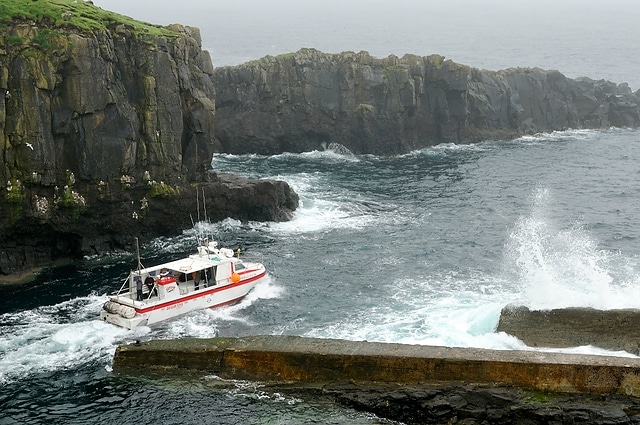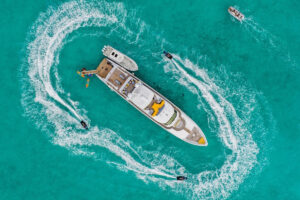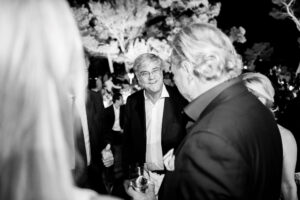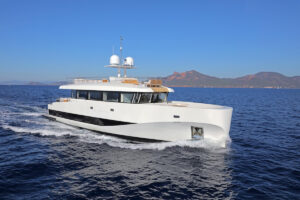
Public Transportation Faroe Style
Docked along the main visitor’s quay in downtown Torshavn, we found ourselves quite the attraction to locals walking and driving by. Many have stopped to ask about Venture II, as it is the largest private yacht in the harbor, and being a powerboat of this size, it is even more unusual. Of particular interest is the fact that it is built of fiberglass. We saw a few passers-by rubbing the hull to feel the molded-in, wooden plank facade of the gleaming gelcoat hull. Tony, now serving as Fleming’s “Ambassador-at-Large,” is an especially gracious owner, often inviting people onboard for a tour_._
Mixed in with all the positive first impressions of the Faroes has been the realization of how much everything costs. While the guidebooks warn of this, it’s still a bit shocking to pay $10 for a beer and $20 for a simple sandwich. The currency is in Danish krónas, and there are roughly 17 krónas to a dollar. After factoring in the exchange rate, lunch for four can easily cost $150. Of course just about everything here, with the exception of fish and wool, must be shipped from the mainland hundreds of miles away.
On Monday, our first full day here, we rented a car and drove to the next island, Eysturoy, to see the picturesque village of Gjógv. While the winding roads are in good condition, they are extremely narrow in many areas, cut into the sides of the mountains and running precariously close to the edge with vertical drops of hundreds of feet. Seeing an approaching truck or bus can be a heart-stopper.
Most of the islands are connected by a series of underwater tunnels, and some tunnels have been dug under the mountains to avoid having to carve longer roads around them. Gjógv is a charming little village built near a dramatic gorge that leads down to the sea. Like much of the Faroes, it is a mixture of old and new. Turf-roofed homes stand next to contemporary structures, and modern fiberglass skiffs share space with traditional wooden craft.
The next day we drove to the island of Vogur hoping to catch a ferry to Mykines, the island known for its population of the photographic puffin, but we unfortunately missed the only morning boat. Although the weather was generally overcast, the dramatic mountain landscapes, lush green valleys and colorful buildings highlighted with sod roofs, are a photographer’s delight. We drove for hours, stopping often to capture these unforgettable sights.
As we arrived at the ferry dock the next morning for our one-hour ride to Mykines, we began to question our preparation, or lack thereof, for the trip. It was drizzling a cold rain, and every other passenger was dressed in heavy-duty foul weather gear or extreme, waterproof hiking outfits. Even their backpacks had rain covers. Most carried telescopic walking sticks. Hmm. What do they all know that we don’t?
The “ferry” was a relatively small, 45-foot boat with a partially protected passenger deck. The passenger limit was posted at 40, and it was clear that we were at or beyond this limit. Nonetheless, we shoved off for the one-hour ride in the open ocean. Our landfall was dramatic to say the least, as we ran parallel to a high wall of rock for 200 yards, no more than two boat lengths off our starboard side. The surge lifted and dropped us as we headed straight towards the rocky shoreline. Suddenly, the captain spun a 180, pointing the bow into the surge as he came alongside a concrete wall and grabbed a spring line from a landside helper.
While the captain kept the engine running at idle and the transmission in gear, we timed our jump to the concrete pier, hoping our backpacks wouldn’t get caught and our footing on the wet surface wouldn’t fail us. From here we climbed 200 feet up a steep path to an overlook, where we could see exactly how precarious the landing is. Understandably, the ferry sometimes has to turn back, unable to land safely if the surge is too great.
People come to this island to hike to its peak and to see and photograph the puffins, but the weather this day made it almost impossible to do either. A combination of rain, fog and high winds made the ascent too difficult for those of us carrying heavy camera equipment, and even if we made it to the top, we wouldn’t be able to see anything to photograph.
The next and last ferry was in five hours, so many of us gathered in a tiny “guesthouse” to stay dry and warm. When it became too crowded with the brave, soaking-wet hikers returning from their climb to the top, several of us took refuge in the church where we were sheltered from the rain and cold wind.
Finally, through the increasingly thick fog and building seas, we saw the ferry approach and do its 180 trick maneuver. From its small cargo hold, cases of beer, produce and building supplies were unloaded for the few people who live here during the summer. We now faced a one-hour ride into heavy winds and head seas, and those who were not completely sheltered took a one-hour saltwater shower. As if out of the Chevy Chase “European Vacation” movie, an elderly British woman who not only had slipped and fallen on her back when boarding but who had been thoroughly drenched with salt spray, simply said, “It was a tad wet, wasn’t it?”
The next day we drove to the north islands, where the weather was nearly perfect. And when the clouds and fog rolled in to spoil our photo opportunities, within a few minutes they would be gone, replaced by sunny, blue skies. The air here in the Faroes is clear and fresh, like Monhegan Island off the coast of Maine, inspiring artists to paint their finest work.
Kneeling down in a field of buttercup flowers while composing a photo in the village of Noródepil, I was approached by a strapping man who introduced himself as Zacharias Hammer. He lived across the street, and when he found out I was a journalist for Yachting magazine, he invited me to his home to share a bowl of special “Viking” soup made of lamb and fish. Zach was a documentary filmmaker on his way to Greenland to shoot a television program. By now Tony had arrived, and the two compared their high-end video cameras, sharing their fondness for Apple’s Final Cut Pro. After soup we had coffee and cookies served by his charming wife, who welcomed us into her home.
These folks were just two examples of the graciousness and warm hospitality we have experienced throughout our visit to these faraway islands. Returning to Venture II late that afternoon, we began our preparation for our 500-mile voyage to Iceland the following day.
Stay tuned, the weather is building.
For a gallery of images from George Sass, Sr.’s Iceland adventure click here.









